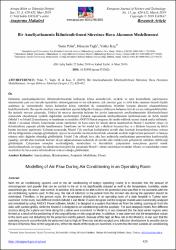| dc.contributor.author | Polat, Yasin | |
| dc.contributor.author | Yağlı, Hüseyin | |
| dc.contributor.author | Koç, Yıldız | |
| dc.date.accessioned | 2020-12-29T10:49:27Z | |
| dc.date.available | 2020-12-29T10:49:27Z | |
| dc.date.issued | 2019 | en_US |
| dc.identifier.citation | Polat, Y., Yağlı, H. & Koç, Y. (2019). Bir Ameliyathanenin İklimlendirilmesi Süresince Hava Akımının
Modellenmesi. Avrupa Bilim ve Teknoloji Dergisi, (15), 420-432.
https://doi.org/10.31590/ejosat.531362 | en_US |
| dc.identifier.uri | https://doi.org/10.31590/ejosat.531362 | |
| dc.identifier.uri | https://hdl.handle.net/20.500.12508/1577 | |
| dc.description.abstract | Günümüz ameliyathanelerinin iklimlendirilmesinde kullanılan klima sistemleriyle; sıcaklık ve nem kontrolünün yapılmasının istenmesinin yanı sıra havada taşınabilen mikroorganizma ve toz miktarının, atık anestezi gazı ve kötü koku oranının önemli ölçüde azaltması da istenmektedir. Ayrıca kullanılan klima sistemleri ile standartlarda belirtilen koruma alanının oluşturabilmesi hedeflenmektedir. Bu sayede ameliyat esnasında kesi yapılan bölgeden hastaya enfeksiyon bulaşma riski de en aza indirgenebilmelidir. Bu nedenle mevcut çalışmada, Türkiye’de mevcut durumda bulunan bir devlet hastanesinin ameliyathanesinin iklimlendirilmesi sonucunda oluşabilecek sıcaklık dağılımları incelenmiştir. Çalışma kapsamında ameliyathanenin incelenmesinde iki farklı model (Model 1 ve Model 2) tasarlanmış ve tasarlanan bu modeller ANSYS Fluent programı ile simüle edilerek sayısal olarak analiz edilmiştir. Model 1 tavandan üfleme, kenarlardan emme menfezleri ile hava emen bir sistem olarak tasarlanırken Model 2 aseptizör cihazı ile iklimlendirme yapacak şekilde tasarlanmıştır. Tasarlanan her bir model için x düzlemi boyunca beş ve z düzlemi boyunca üç farklı kesitte inceleme yapılmıştır. Çalışma sonucunda, Model 1’de ameliyat lambalarının cerrahi alan üzerinde konumlandırılması sonucu ölü kış bölgelerinin oluştuğu görülmüştür. Ayrıca bu modelde incelenen kesitlerde salondaki sıcaklık değerlerinin personeli ve hastayı rahatsız edici değerler olmadığı görülmüştür. Model 2’de yüksek hava akış hızı nedeniyle ameliyathane personelinin konforsuzluk yaşadığı, cerrahi alan üzerinde laminer akışın sağlanamaması nedeniyle de cerrahi alan enfeksiyonu gelişiminin mümkün olabileceği görülmüştür. Çalışmanın sonuçları incelendiğinde, standartlara ve literatürdeki çalışmaların sonuçlarına paralel olarak ameliyathanelerde en uygun havalandırma tekniğinin bu çalışmada Model 1 olarak tanımlanan tavandan üfleme ve kenarlardan emme menfezleri ile hava emen iklimlendirme sistemi olduğu görülmüştür. | en_US |
| dc.description.abstract | With the air conditioning systems used in the air conditioning of today's operating rooms; it is desirable that the amount of microorganism and powder that can be carried in the air to be significantly reduced as well as the temperature, humidity, waste anaesthesia gas, the odour ratio control. In addition, it is aimed to be able to form the protection area specified in the standards with the air-conditioning systems used. In this way, the risk of infection to the patient from the incision site during the operation should be minimized. Therefore, in the present study, the temperature distribution in an operating room of a state hospital in Turkey were examined. In the study, two different models (Model 1 and Model 2) were designed and the designed models were numerically analysed and simulated by using ANSYS Fluent software. Model 1 is designed as a system that blows air from the ceiling, sucking air from the sides with suction grilles, while the Model 2 is designed to air-conditioning with the aseptizer. For each designed model, five different sections along the x-plane and three along the z-plane were examined. In Model-1, it was observed that the dead winter regions were formed as a result of the positioning of the surgical lamps on the surgical area. In addition, it was observed that the temperature values in the room were not disturbing for the personnel and the patient. Because of the high air flow rate in the Model 2, it was seen that the operating room is uncomfortable the personnel due to high air flow rate and also surgical area infection development is possible due to the lack of laminar flow on the surgical area. When the results of the study are examined, it is seen that the most suitable air-conditioning system for the operating rooms in accordance with the standards and the results of the studies in the literature is air-blowing from the ceiling and air-sucking from the sides with suction grilles system, which is defined as Model 1 in the present study. | en_US |
| dc.language.iso | tur | en_US |
| dc.publisher | Avrupa Bilim ve Teknoloji Dergisi | en_US |
| dc.relation.isversionof | 10.31590/ejosat.531362 | en_US |
| dc.rights | info:eu-repo/semantics/openAccess | en_US |
| dc.subject | Ameliyathane | en_US |
| dc.subject | İklimlendirme | en_US |
| dc.subject | Aseptizör | en_US |
| dc.subject | Modelleme | en_US |
| dc.subject | Fluent | en_US |
| dc.subject | Operating room | en_US |
| dc.subject | Air conditioning | en_US |
| dc.subject | Aseptizer | en_US |
| dc.subject | Modelling | en_US |
| dc.title | Bir Ameliyathanenin İklimlendirilmesi Süresince Hava Akımının Modellenmesi | en_US |
| dc.title.alternative | Modelling of Air Flow During Air Conditioning in an Operating Room | en_US |
| dc.type | article | en_US |
| dc.relation.journal | Avrupa Bilim ve Teknoloji Dergisi | en_US |
| dc.contributor.department | Mühendislik ve Doğa Bilimleri Fakültesi -- Makina Mühendisliği Bölümü | en_US |
| dc.contributor.authorID | 0000-0002-1255-9990 | en_US |
| dc.contributor.authorID | 0000-0002-9777-0698 | en_US |
| dc.contributor.authorID | 0000-0002-2219-645X | en_US |
| dc.identifier.issue | 15 | en_US |
| dc.identifier.startpage | 420 | en_US |
| dc.identifier.endpage | 432 | en_US |
| dc.relation.publicationcategory | Makale - Ulusal Hakemli Dergi - Kurum Öğretim Elemanı | en_US |
| dc.contributor.isteauthor | Yağlı, Hüseyin | |
| dc.contributor.isteauthor | Koç, Yıldız | |
| dc.relation.index | TR-Dizin | en_US |
















